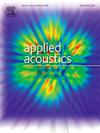尾翼尾缘宽带降噪的实验研究
IF 3.4
2区 物理与天体物理
Q1 ACOUSTICS
引用次数: 0
摘要
后缘锯齿作为一种有效的降低湍流边界层后缘噪声的技术已经得到了广泛的应用。在本文中,进行了一项实验运动,研究了电磁波对TE降噪的影响。齿形安装在NACA 0012型机翼上,并在气动声学风洞中进行了测试。各种几何形状的Ogee锯齿被改装到机翼上,并在各种流速和攻角(AoAs)下进行了测试。ogee锯齿的几何形状由不同的锯齿波长(λ)、振幅(2h)和锐度因子(b)来参数化。传统锯齿锯齿,被认为是一个特殊的情况下,当它的锐度系数接近零,也包括。通过改变锯齿的每个几何参数,对TE降噪进行了灵敏度分析。结果表明,在不同的流量下,ogee serserss的降噪效果可达1 ~ 3 dB。随着AoA的增加,降噪效果逐渐减弱,直到AoA≥15°处出现噪音增加。特别是,它表明,当锯齿是足够尖锐(大2h,小λ,大b)在中高频锯齿优于锯齿锯齿,根据分析预测。本文章由计算机程序翻译,如有差异,请以英文原文为准。
An experimental investigation into the aerofoil trailing-edge broadband noise reduction using ogee serrations
Trailing edge (TE) serrations have been widely used as an effective technique to reduce the turbulent boundary-layer TE noise. In this paper, an experimental campaign is carried out to study the effects of ogee serrations on TE noise reduction. Serrations are installed on a NACA 0012 aerofoil and tested in an aeroacoustic wind tunnel. Ogee serrations of various geometries are retrofitted to the aerofoil and tested at various flow speeds and angles of attack (AoAs). The geometry of ogee serrations is parametrized by varying serration wavelength (λ), amplitude (2h), and sharpness factor (b). Traditional sawtooth serrations, considered a special case of ogee serration when its sharpness factor approaches zero, are also included. A sensitivity analysis of the TE noise reduction is conducted by varying each geometric parameter of the serrations. Results show that ogee serrations achieve effective noise reduction of 1-3 dB under various flow speeds. With the increase of AoA, the noise reduction gradually diminishes until noise increase occurs at AoA . In particular, it is shown that ogee serrations outperform sawtooth serrations when the serration is sufficiently sharp (large 2h, small λ, and large b) at intermediate and high frequencies, in accordance with analytical predictions.
求助全文
通过发布文献求助,成功后即可免费获取论文全文。
去求助
来源期刊

Applied Acoustics
物理-声学
CiteScore
7.40
自引率
11.80%
发文量
618
审稿时长
7.5 months
期刊介绍:
Since its launch in 1968, Applied Acoustics has been publishing high quality research papers providing state-of-the-art coverage of research findings for engineers and scientists involved in applications of acoustics in the widest sense.
Applied Acoustics looks not only at recent developments in the understanding of acoustics but also at ways of exploiting that understanding. The Journal aims to encourage the exchange of practical experience through publication and in so doing creates a fund of technological information that can be used for solving related problems. The presentation of information in graphical or tabular form is especially encouraged. If a report of a mathematical development is a necessary part of a paper it is important to ensure that it is there only as an integral part of a practical solution to a problem and is supported by data. Applied Acoustics encourages the exchange of practical experience in the following ways: • Complete Papers • Short Technical Notes • Review Articles; and thereby provides a wealth of technological information that can be used to solve related problems.
Manuscripts that address all fields of applications of acoustics ranging from medicine and NDT to the environment and buildings are welcome.
 求助内容:
求助内容: 应助结果提醒方式:
应助结果提醒方式:


